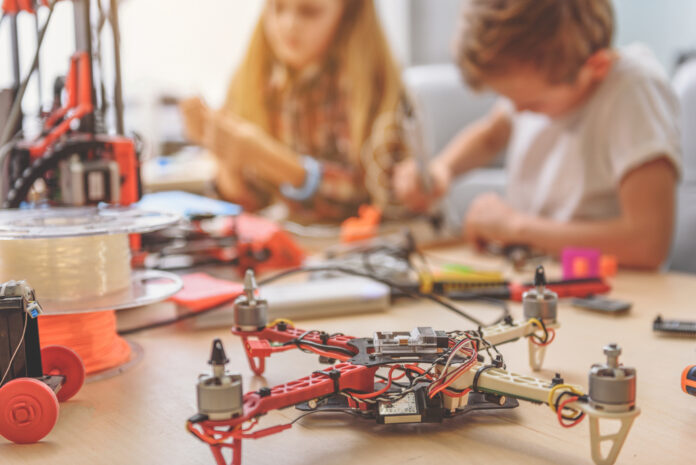The thrill of seeing the world from a bird’s-eye view has captivated humans for generations. With the advent of drone technology, this dream is now accessible to hobbyists around the world. Building and flying drones isn’t just a pastime; it’s an immersive experience that combines creativity, technology, and adventure.
Why Choose Drone Flying as a Hobby?
Drone flying offers a unique blend of excitement and learning. Whether you’re interested in aerial photography, racing, or simply exploring the skies, drones provide a platform for endless possibilities. They allow hobbyists creative expression and an adrenaline rush, especially with racing drones ¹.
Getting Started: Understanding Drones
Before you take to the skies, it’s essential to understand the basics of drones:
- Types of Drones: From tiny whoops for indoor flying to larger drones like XClass for racing or cinematography, there’s a drone for every interest ².
- FPV (First Person View) Drones: These drones provide an immersive flying experience by transmitting live video feed to goggles, making you feel like you’re in the cockpit.
Building Your Own Drone
Building a drone from scratch not only saves costs but also enhances your understanding of how drones work. It offers hands-on experience in electronics and aerodynamics and fosters technical skills ¹.
Essential Components
To build a drone, you’ll need:
- Frame: The skeleton of your drone. Frames come in various configurations—tricopters, quadcopters, hexacopters, and octocopters ³.
- Motors: Choose between brushed and brushless motors. Brushless motors are preferred for durability and performance ³.
- Electronic Speed Controllers (ESCs): These regulate motor speed.
- Propellers: Propeller choice affects the drone’s lift capacity ³.
- Flight Controller: The brain of your drone.
- Power Distribution Board (PDB): Manages power from the battery to the components.
- Battery: LiPo batteries are common due to their high capacity and output.
- Transmitter and Receiver: For controlling your drone.
- FPV Camera and Goggles: For live video feed.
- Optional: GPS module, telemetry systems, and action cameras for recording.
Step-by-Step Building Guide
- Assemble the Frame: Start by putting together the drone frame according to the manufacturer’s instructions.
- Install Motors and ESCs: Secure the motors using screws and connect them to the ESCs ⁴.
- Mount the Flight Controller: Place it at the center of the frame for balance.
- Connect the PDB: The PDB acts as the central hub for all power connections ³.
- Attach the Receiver and Antennas: Ensure they are securely connected and positioned for optimal signal strength.
- Add the FPV System: Install the camera and video transmitter.
- Install Propellers: Attach them carefully, ensuring they’re on the correct motors.
- Configure the Flight Controller: Use software like Betaflight to set up your drone’s settings.
Learning from Experienced Hobbyists
Over the years, enthusiasts have expanded their skills significantly, learning to fly and even achieving autonomous flight with advanced setups ⁵. Engaging with the community can provide valuable insights and tips.
Learning to Fly
Before taking your custom drone on its maiden voyage:
- Practice on Simulators: Simulators minimize damage to physical drones and hone control ⁶.
- Start Slow: Begin with a durable, beginner-friendly drone to get a feel for the controls ⁷.
- Join Local Clubs: Flying with others can accelerate your learning and make the hobby more enjoyable.
Safety and Regulations
Safety should be your top priority:
- Understand Local Laws: Operating drones requires a significant understanding of safety protocols to avoid accidents and legal issues ¹.
- Perform Pre-flight Checks: Ensure all components are functioning correctly.
- Fly in Open Spaces: Avoid crowded areas to minimize risks.
Expanding Your Hobby
As you become more comfortable:
- Customize Your Drone: Experiment with different components to enhance performance.
- Try Aerial Photography: Drones allow hobbyists creative expression through stunning visuals ¹.
- Participate in Races: Test your skills against other pilots.
Conclusion
Building and flying drones is a rewarding hobby that combines technical skills with creative freedom. From the initial assembly to soaring through the skies, each step offers a unique thrill. The drone industry is young and rapidly evolving, with opportunities for those who invest in proper training and compliance ¹.
Ready to start your drone adventure? Check out these beginner-friendly kits:
Note: Always ensure compatibility between components when building your drone.
References
¹ Pilot Institute – Is Buying a Drone Worth It?
² Oscar Liang – FPV Drone Guide
³ Dojo for Drones – Build a Drone
⁴ Instructables – Super Stable Multi-Rotor Setup/Build Guide for Beginners
⁵ Team-BHP – Reminiscing My Old Hobby: Building & Flying RC Planes & Drones


